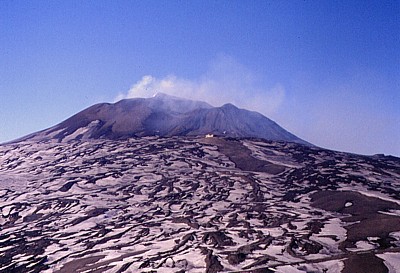| Etna
index |
||
| Geology | Geological history | Cones and craters |
| Eruptive characteristics | Eruptions before 1971 | Eruptions since 1971 |
| Etna and Man | References | Web sites |
| Weather forecasts | FAQ | Latest news |
| View
from the Montagnola toward the summit craters of Etna on 12 February
1998. The Southeast Crater, which has changed beyond recognition
since then, lies to the right of the then much larger central summit
cone, and a small intracrater cone looms over its rim. This cone,
which began to form about one year earlier, was the site of a fairly
regular Strombolian activity, and lava issued from vents at its
base, overflowing the crater rim in many places. The building in
front of the Southeast Crater is the Torre del Filosofo mountain
hut, an amazingly ugly structure (in terms of architecture), which,
however, has provided shelter and served for hosting scientific
monitoring instruments. In spite of its exposed location and its
proximity to the eruptive sites of 2001 and 2002-2003, it is still
there... though completely buried by the pyroclastic products of
the latest eruption |
Etna
photo gallery: 1999
Etna's unrivalled beauty
![]()
Following
the spectacular and extremely varied summit activity of the previous
year, the year 1999 brought a still more exciting period of summit
eruptions. At the beginning of the year, the Southeast Crater continued
its series of paroxysms initiated in September 1998, and mild explosive
activity occurred at the Bocca Nuova. The last of the Southeast
Crater paroxysms, on 4 February, evolved into a fissure eruption
splitting the southeastern slope of its cone and continuing for
the next nine months with the emission of lava. Hundreds of thousands
of tourists were attracted by this activity, which could be easily
observed at close range. During the spring of 1999, the Voragine,
which had been silent since September 1998, reactivated, and on
4 September produced another exceptionally violent paroxysm. This
event was accompanied by strong activity also at the Bocca Nuova
and the Southeast Crater, and heavy tephra falls caused significant
damage to cultivated land and infrastructures on the eastern flank.
The lava fountains produced at the Voragine on 4 September 1999
are probably the tallest ever observed on any volcano on Earth,
rising more than 2000 m above the summit. As if stimulated by the activity of the nearby Voragine, the Bocca Nuova entered into a phase of intense activity shortly thereafter, which culminated with a month-long eruption in October-November 1999 that generated lava fountains and copious lava overflows onto the western flank of the volcano. Small pyroclastic flows were also observed on one occasion. At that time the effusive activity near the Southeast Crater was still in progress, so that for the first time in recorded history there was lava emission at the summit of Etna in two distinct places. By mid-November, the activity subsided, and the volcano was relatively calm for two months. But this was just a temporary respite; the Southeast Crater was to give yet another incredible display soon thereafter. |
|
The photographs taken of Etna in 1999 are so numerous that they are presented on separate pages: Into the heart of Etna, 21 January 1999 The dance of the lava, February 1998 Lava, more lava, and still more lava, March 1999 Lava flowing undercover, April 1999 A tumulus breaks asunder, May 1999 The return of explosive activity, June 1999 |
Copyright © Boris Behncke, "Italy's Volcanoes: The Cradle of Volcanology"
Page set up on 7 February 2004

